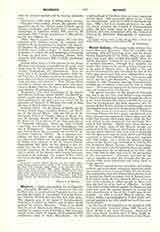

Mocovi Indians. The name is also written Ma-coblo, Meoconi, Mocoblo. They are a warlike and predatory tribe of Guaycuran stock, and are closely related linguistically to the Toba, Mbaya, and Abipon, their usual allies, settled principally along the middle and upper Vermejo River, in the Chaco region of northern Argentina, although they formerly extended their forays as far south as Santa Fe and even to the gates of Buenos Aires. In habit of life and general characteristics they resembled the rest of the tribes just mentioned, but were distinguished even beyond them, as Dobrizhoffer says, “in atrocity and steady hatred to the Spaniards. They seemed to conspire to ruin Tucuman, proving themselves formidable, not to solitary estates merely, but to whole cities”. They entirely destroyed the town of Concepcion and massacred its inhabitants.
This special hostility to the people of Tucuman was due to the fact that years before a large number of Mocovi, who had been induced through the efforts of the Jesuit Fathers Altamirano and Diaz to come in from the war-path and had been organized into the mission of San Xavier, had been treacherously seized and distributed as slaves by the governor of that province. They received a temporary check in 1710 from Governor Urizar, who led a great expedition of over three thousand men against the Chaco tribes, with the result that several tribes made peace, while the Mocovi retired to the southwest and continued their raids in that quarter. Thirty years later, during a period of truce, some of the Mocovi became acquainted with the Jesuits of the College of Santa Fe, through whose influence they were won to friendship with the Spaniards, and the chiefs Aletin and Chitalin consented to receive Christian instruction together with their people. As a result the Mocovi mission colony of San Xavier was established in 1743 by Father Francisco Burges Navarro, thirty leagues from the city, and from a small beginning increased rapidly by accessions from the roving bands of the tribe, who were, from time to time, won over by the persuasions of the new converts. Prisoners captured in the various expeditions were also brought into the new mission, while many voluntarily took refuge there to escape pursuit.
The Mocovi proved devout, tractable, and willing workers, and particularly competent musicians under the instruction of the German Father Florian Pauke, who organized a band and chorus whose services were in demand on church occasions even in Buenos Aires. With bell in hand, the chief himself, Aletin, acted as crier every morning to call his people to Mass, and took the lead in every task of difficulty. A third chief, who had long held out against the Spaniards and made war upon his mission kinsmen in revenge for their abandonment of the old life, finally came in voluntarily. In 1765 a second Mocovi mission, San Pedro y Pablo, was established by Father Pauke with another portion of the tribe which had until then continued hostile.
At the time of the expulsion of the Jesuits in 1767 the two missions contained about 1200 Mocovi of whom all but a few were Christians. Deprived of their accustomed teachers, most of them finally rejoined their wild kinsmen in the forests of the Chaco. In 1800 the tribe was still loosely estimated at 2000 warriors or over 6000 souls. They are now reduced far below that number, but retain their tribal or-ganization and habits, though no longer hostile, and range generally along the western banks of the Parana. The best study of their language is Father Tavolini’s “Introduction al Arte Mocovi”. (See also Toba Indians.)
JAMES MOONEY

